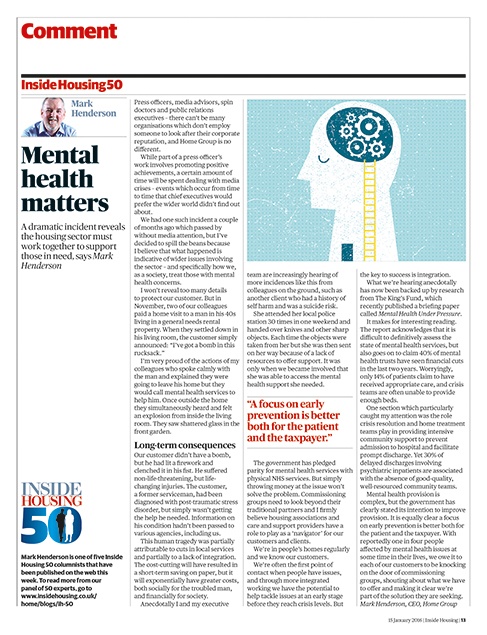Passing the buck
With councils’ budgets squeezed Emily Twinch finds out what is being done to stop vulnerable people falling between the gaps
Video:
feea

Last November, housing staff at Home Group were confronted with a tenant claiming to have a bomb in his bag; also last year, an officer from an unnamed housing provider claims to have been held hostage by a man who believed there was an alien outside his home.
Perhaps unsurprisingly, the tenants in both incidents had mental health issues.
Inside Housing’s Safety at Work survey, published in June, revealed a litany of threats to staff or incidents in which they could not access homes for repair works. Again, these situations often involved tenants with unsupported mental health needs.
Frontline staff are compiling anecdotal evidence of growing numbers of tenants with mental health issues ending up in general needs housing, where they do not receive the help provided in specialist supported housing. But is this actually the case? And if so, what can be done to improve the situation?
Video:
Ad slot
Figures obtained under the Freedom of Information (FOI) Act show a 14% drop in spending on mental health in supported housing since 2011/12 among the 47 English councils that responded to the question in full. In 2011/12, the councils’ combined budget, including both commissioned services and those they pay for directly, was £50.9m; this year’s budget is £43.6m.
This squeeze on council spending has in turn put pressure on other housing providers.
“We have noticed councils are seeking to reduce the amount of specialist accommodation they procure for adults with mental illness,” says Alex Reeve, regional director of London supported housing at Family Mosaic.
Mr Reeve adds that town halls are “increasingly asking landlords to provide the required support”, with accommodation paid for by housing benefit.
Home Group chief executive Mark Henderson, who revealed the incident of the man who claimed to have a bomb in a column for Inside Housing in January, says that his organisation has seen “the complexity and prevalence of poor mental health increase” in the 40 years it has provided supported housing.

Mark Henderson’s column, where he explains the firework incident
In the incident in question, the man was actually holding a lit firework and suffered life-changing injuries when it exploded.
The example shows the urgency of the problem for many frontline staff, but as Mr Henderson wrote in January: “Simply throwing money at the issue won’t solve the problem.”
He continues: “We’re often the first point of contact when people have issues, and through more integrated working, we have the potential to help tackle issues at an early stage before they reach crisis levels. But the key to success is integration.”

Stretched resources
Money might not be the answer, but it is a start. Yet supported housing has been operating within a constricted funding environment for years.
Supporting People funding - a national programme for housing-related support made available to councils in England - dropped from £1.8bn when it started in 2003 to £1.6bn in 2014/15. That 11% fall equates to 38% in real terms.
Ministers have given supported housing a one-year exemption from the 1% rent reduction announced in last year’s summer Budget, while earlier this month the government said it would transfer top-up money to councils for the service to counter its planned housing benefit cap. But supported housing providers say the threat of funding cuts has already affected business.
Among the 250 councils that responded at least in part to Inside Housing’s FOI requests, there is a wide range of provision for tenants with mental health conditions: some have specialist units, some do not; a handful have floating support for their general needs stock, most do not; others have budgets for specific conditions - such as hoarding - while others have no housing budget at all allocated to people with mental health needs.
Recent statistics from the charity YoungMinds suggests the nation’s mental health is worsening, with a 68% increase in the numbers of young people admitted to hospital because of self-harm over the past 10 years.
Meanwhile, the dwindling supply of mental health beds across the country is leading to more people in need turning up on the doorsteps of housing providers.
NHS figures reveal 23,253 beds were available for people with mental health needs in England between April and June 2011. By the same quarter in 2013 that number had dropped to 22,109, while this year it was just 18,919 beds.
“Boroughs are stretched. A lot of the preventative services have been cut back or [have become] floating support for low-level needs” Chris Hampson, chief executive, Look Ahead
Chris Hampson, chief executive of Look Ahead, which provides care, support and housing services across London and the South East, says that this has resulted in councils cutting back on supporting those with lower-level mental health issues to concentrate on those with more acute needs.
“Boroughs are stretched. A lot of the preventative services have been cut back or [have become] floating support for low-level needs.”
He says this is a “short-sighted” solution. “If you take money out of the lower-end preventative services, in the long run, more money is spent because people end up back on the streets or in hospital.”
He feels it is still better for people with mental health issues to be treated in the community, but that money should be shifted from the NHS to councils to allow them to provide wrap-around services for people who need them.
Richard Colwill, media manager at mental health charity Sane, says the FOI results show the “budgetary crisis” across the board for mental health provision, which is of “deep concern” for the charity.
“Mental health has always been a ‘Cinderella service’,” he explains, but cuts to services are a “false economy”. “If people do not have early support they risk becoming more unwell, which can affect their prospects for recovery.
“Care in the community only works if there is provision for people in the community. Housing is a really big issue for us. Losing a home or being in fear of losing your home can be a trigger to push someone into crisis.”
Exceptions to the rule
While most councils have cut spending on mental health in supported accommodation, the FOI responses reveal some exceptions.
In 2016/17 Ealing spent £1.6m on mental health in supported housing, up from £1.2m in 2011/12.
“We recognise the benefits of supported living in enabling people to live as independently as possible in the borough while getting appropriate care from professionals,” a spokesperson for Ealing says.
“We also find that supporting people to live in the local area near to family and friends can have a positive impact on their well-being.”
Some housing associations are also bolstering mental health services.
Midland Heart has made steps to tackle the issue and has been piloting a so-called ‘people team’ since December last year. The team is made up of housing officers who pinpoint the root causes of reports of anti-social behaviour, which is often caused by mental health issues.
While one team carries on with routine housing management duties for other tenants, a secondary team gives a more supportive service to tenants engaging in anti-social behaviour. This help can include linking people to the right services they need - such as mental health teams or charities - and helping them keep up with the rent.
Nigel Collumbell, head of neighbourhoods at Midland Heart, says: “By investing time and energy into really understanding the needs of our customers, we have helped to address what could initially appear to be a tenancy problem, to find a much more complex issue - such as supporting a customer who is experiencing mental health issues.
“In their first six months of operation our new people team have successfully supported nine out of 10 customers to sustain their tenancies using a case management approach.”

In June this year, Inside Housing reported on assaults on housing staff
The ‘second team’ has had specific training on safeguarding and mental health, and will have more in the future.
Mr Collumbell says one problem the team often encounters is getting necessary information from the health services. “These hurdles to obtaining information can sometimes mean we stay involved with tenants for longer than we would otherwise need to because getting to the root cause of their behaviour is more difficult.”
A partnership of 40 housing associations in Birmingham is tackling this problem.
Alan Moorhouse, project manager of Birmingham Social Housing Partnership (BSHP) - which works to strengthen relationships between housing associations and other organisations - has been working to improve communication between housing providers and mental health workers.
“We talked to housing professionals in the summer last year and asked: ‘What are the big issues?’ The top one was mental health.
“A big driver for us was feedback from professionals recognising poor mental health was having a big impact on tenancy sustainment.”
“We talked to housing professionals in the summer last year and asked: ‘What are the big issues?’ The top one was mental health,” Alan Moorhouse, project manager, Birmingham Social Housing Partnership
Sharing information
The group has set up a monthly working group with councils, housing providers and mental health workers.
“We are encouraging information sharing and developing more effective discharge procedures,” Mr Moorhouse adds. “If someone comes out of a mental health trust setting we want to ensure the housing provider is aware of any issues that may affect tenancy sustainment and can arrange the right kind of tenancy support.”
In Yorkshire, Wakefield Council is another bucking the trend, with its supported housing mental health budget growing 15% in the past five years. It is also developing an innovative strategy to address the issue.
Wakefield and District Housing has partnered with NHS Wakefield Clinical Commissioning Group to employ mental health support workers to work with tenants. The council, which still manages the local housing register, can give applicants with mental health needs extra priority.
Jon Feasey, a service manager for vulnerable adults at Wakefield Council, says: “We see it [tackling mental health] as an important frontline service. It has a preventative outcome that can create real efficiencies by preventing homelessness.”
He believes the right place for people with mental health needs is in the community but that people need support in their homes - including those with lower level, less acute, mental health needs, who can slip through the net.
As well as preventing homelessness the support can also help “reduce unplanned hospital admissions”, Mr Feasey states.
As the number of people needing care in the community grows, housing providers will need to have systems in place to deal with the cases that will come their way. Otherwise, they will likely see more issues with rent arrears, anti-social behaviour and safeguarding for staff and other tenants.
Some are taking action, but with dwindling funds available, those on the frontline see greater integration with health services and a focus on prevention as the best way ahead.
Care in the community
People with mental health needs have increasingly been living in the community since the 1950s as society has moved away from the psychiatric institutions of the Victorian age.
The Mental Health Act 1959 encouraged care in the community. Some 150,000 beds in mental health hospitals disappeared between that year and 1975, according to the BBC.
At the same time, large-scale psychiatric hospitals closed.
The Community Care Act 1990, which was the first major reform of the NHS since it began in 1948, established local authorities’ duty to assess anyone who appeared to need care in the community.
Health and housing have been developing close links in recent years, including the provision for people with mental health. In March 2015 an NHS England mental health task force was set up and a national strategy published in February 2016 as a response to its final report.
The report recommended the creation of prevention plans in every community across England to “help integrate public health, social care and housing, and improve mental health outcomes, with mental health champions in each community”.